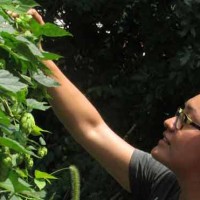Hip Hop Hooray for Humulus lupulus!

Hops, like valerian, are a traditional herbal remedy for anxiety, restlessness and insomnia.
You may be familiar with hops in association with beer brewing (where it is used as an anti-bacterial agent and for flavoring brews). I am simply happy to brew up a relaxing tea for those nights I have trouble winding down to sleep. When I decided to take an indefinite break from alcohol consumption, I swapped out my nightly beer for hops tea to get a similar calming, sleepy effect without the nasty hangover. If you are living sober and want a good substitute for beer to help soothe you, try some hops tea. The active ingredient in hops is a chemical component called dimethylvinyl carbinol, a known sedative and hypnotic.
This week Paul, Adrienne and I rescued a mess of hops for our friend Charlie. He had planted hops in his lush perennial garden and ended up with more hops than he knew what to do with, and didn’t want to see them go to waste. Paul noted that hops are in the Cannabis family, Cannabidaceae, making it the legal cousin of marijuana (that explains its mellowing effect). He also mentioned that you can fill a pillow with hops for soothing rest to give as a crafty, healing gift.
- Hops Tea
- Hops growing on a vine
What are hops?
Hops are the cones (flowers) of a vigorous climbing perennial herb, Humulus lupulus, whose name sounds like a magical herb or spell out of Harry Potter.
How to find hops
If you don’t have a friend like Charlie to invite you to pick hops, you can keep an eye out in the late summer for a plant that climbs like a honeysuckle. If you need help you can sign-up for our workshops, or download the Suburban Foragers iPhone app as a high-tech guide (coming 2013), or buy our weather-resistant guide for a low-tech reference to take into the field.
How to harvest hops
Hops are ready to harvest when they are green and papery. Look inside for golden pollen-like lupin and give it a sniff for that hoppy beer fragrance. Pluck the cones (flowers) off the vine with your fingers or harvest entire clusters by clipping off the lateral vines. When you get home lay them out to dry in a ventilated area out of the direct sun. You may simply spread them on a sheet in an unlit room by a breezy window or under a fan for about 3 days. Or you may hang the lateral vine clippings from hooks or strings in a breezeway for 3 days. When they have dried, place them in an airtight jar in a dark cupboard. Some harvesters suggest freezing them in an airtight bag. They will keep for a year before they lose their potency.
Here’s an excellent how to video on harvesting hops. Ben shows the difference between mature and immature hops.
Brewing hops tea
To make a non-alcoholic homebrew use about 3-5 hop cones per cup of tea. Simply pour boiling water over them, cover and steep for 5-20 minutes. This is a bitter brew (which I like), but you may sweeten it up with honey or sweet herbs like mint.
Edibility
The young leaves of Humulus Lupulus can be eaten as a wild food.
Poisonous Look Alikes
None
Warnings
According to the Plants for the Future entry on hops some people have experienced skin and eye irritation. Some depressed people have felt worse from the sedative effects. They advise to avoid hops during pregnancy (antispasmodic) and with breast, uterine and cervical cancers.
Do not let your dog eat hops. Hops can cause malignant hyperthermia, fatal in dogs.Source Wikipedia.
Paul, Adrienne and I can vouch that we have not personally experienced nor have known anyone to have experienced the side effects mentioned above.
What experience have you had with hops? Please share! We welcome your feedback, questions and personal experience.






Comments
Powered by Facebook Comments